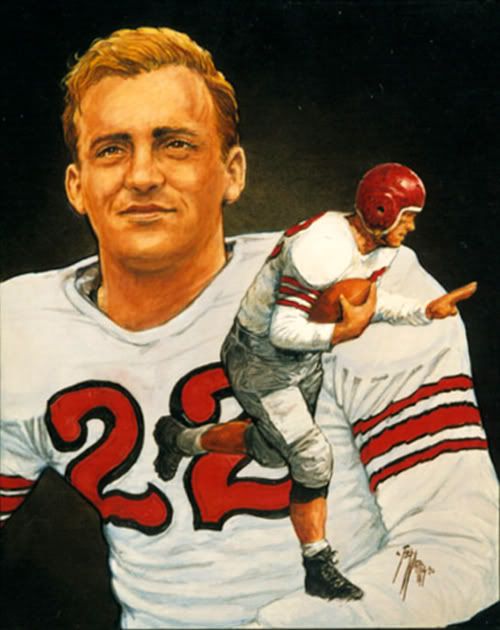 Buckeye Archive
Buckeye Archive  The Magnificent Six: #4 - The 1944 Ohio State Buckeyes
The Magnificent Six: #4 - The 1944 Ohio State Buckeyes
 Checking in at #4 on the list of the six greatest seasons of Ohio State football is the 1944 season.
Checking in at #4 on the list of the six greatest seasons of Ohio State football is the 1944 season.
The Magnificent Six : #6 - The 1961 Ohio State Buckeyes
The Magnificent Six : #5 - The 1973 Ohio State Buckeyes
When it comes to a Columbus, Ohio autumn, a perfect record, a Big Ten title, and a Heisman Trophy winner are about as close to Valhalla as it gets. And that's what Ohio State enjoyed in 1944, as they became the best of the "civilian" teams in this war year.
4.) 1944
Record: 9-0 (6-0 Big Ten)
Big Ten Conference Champions
Missouri (3-5-2) W 54-0
Iowa (1-7) W 34-0
@ Wisconsin (3-6) W 20-7
Great Lakes Naval W 26-6
Minnesota (5-3-1) W 34-14
Indiana (7-3) W 21-7
Pitt (4-5) W 54-19
Illinois (Cleveland) (5-4-1) W 26-12
Michigan (8-2) W 18-14
The Buckeyes had lost head coach Paul Brown to service at the Great Lakes Naval Training Center, but they still had enough brainpower and manpower to garner the school's first perfect season since 1916 and only it's second ever. Led by Paul Brown's former right-hand man Carroll C. Widdoes, Ohio State boasted four All-Americans in 1944: end Jack Dugger, whose brother Dean earned the same honors for the 1954 National Championship team (and who also started on Ohio State's 1944 Final Four basketball squad); guard William Hackett; tackle Bill Willis; and the crown jewel of the 1944 Buckeyes, halfback Leslie Horvath, who ran for 924 yards, threw for 344, scored 12 touchdowns, passed for six, kicked, played defense, and did pretty much everything except engineer the train on road trips. Horvath beat out Army's Mr. Inside-Mr. Outside combo of Glenn Davis and Doc Blanchard to become the first of seven Ohio State Heisman Trophy winners.
The rest of the Buckeyes aside from Horvath weren't too shabby either, and showed it in a dominant campaign. They blew through their schedule, winning their first eight games by an average score of 34-8. Included in the streak was a decisive romp over Paul Brown's Great Lakes Naval Station squad, a revenge triumph over Wisconsin, which handed the 1942 national-title team its only loss, and a victory over Illinois in front of more than 83,000 fans at Cleveland Municipal Stadium.
The toughest test came in the season finale against Michigan. Fritz Crisler's sixth-ranked Wolverines were 8-1 and had smoked the Buckeyes 45-7 the previous year in Ann Arbor. The game was a back-and-forth classic, with the lead changing hands five times. Michigan edged out in front 14-12 midway through the fourth quarter, but Ohio State slugged their way back with a gut-check 14-play drive that ended when Horvath plunged in from the one with 3:16 to play, giving the Buckeyes the lead and the game, 18-14.
That turned out to be the last game of the 1944 season for the Scarlet and Grey. Back then the Big Ten Conference enforced a ban on postseason participation, and after an attempt to send Ohio State to the Rose Bowl was voted down, the Buckeyes stayed home for the New Year, content with their undefeated record, Heisman Trophy winner, and number-two ranking in the national polls.
- NBA Announces 2013-2014 Schedule
- Browns Ink Sharknado
- Sharknado A No-Show For Rookie Camp
- Trent Richardson Out Until Training Camp
- Browns Sign Brandon Jackson
- Carrasco Suspended Eight Games
- Browns Add to Wide Receiver Depth with David Nelson
- Browns Need to Learn from Past Draft Mistakes
- Browns Release Chris Gocong and Usama Young
- Browns Missing on Grimes Disappointing, But Not The End
The TCF Forums
- Official- Browns Coach Search/Rumors
Hikohadon (Tuesday, January 21 2014 1:24 PM) - Movies coming out
rebelwithoutaclue (Tuesday, January 21 2014 12:56 PM) - 2015 Recruiting
jclvd_23 (Tuesday, January 21 2014 12:38 PM) - The 2014 Offseason Thread
Larvell Blanks (Tuesday, January 21 2014 12:25 PM) - Chris Grant's first 3 drafts
Kingpin74 (Tuesday, January 21 2014 10:13 AM) - Mike Brown
YahooFanChicago (Monday, January 20 2014 11:15 PM) - 2014 Hoops Hockey Hijinx
jpd1224 (Monday, January 20 2014 4:44 PM) - 2014 Recruiting
jclvd_23 (Monday, January 20 2014 2:26 PM) - Wish List - #4 Pick
Hikohadon (Monday, January 20 2014 1:26 PM) - #1 overall pick Anthony Bennett
TouchEmAllTime (Sunday, January 19 2014 1:28 PM)



